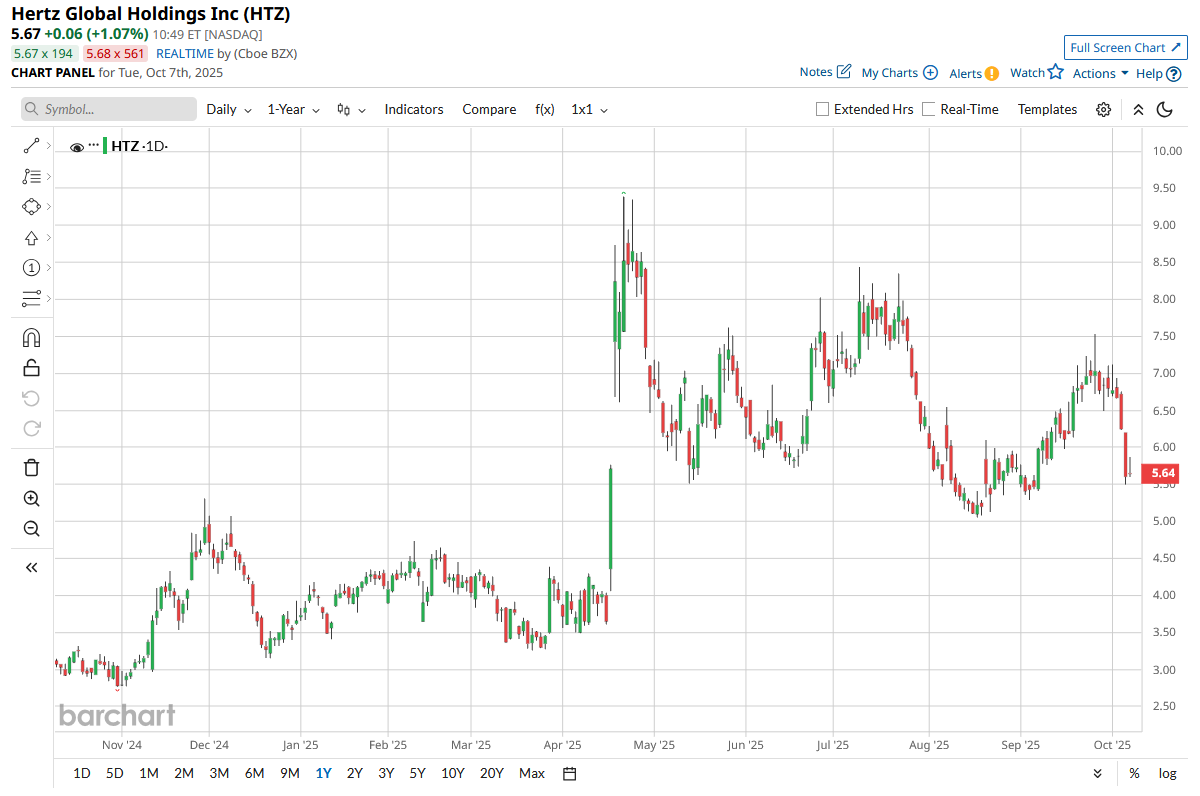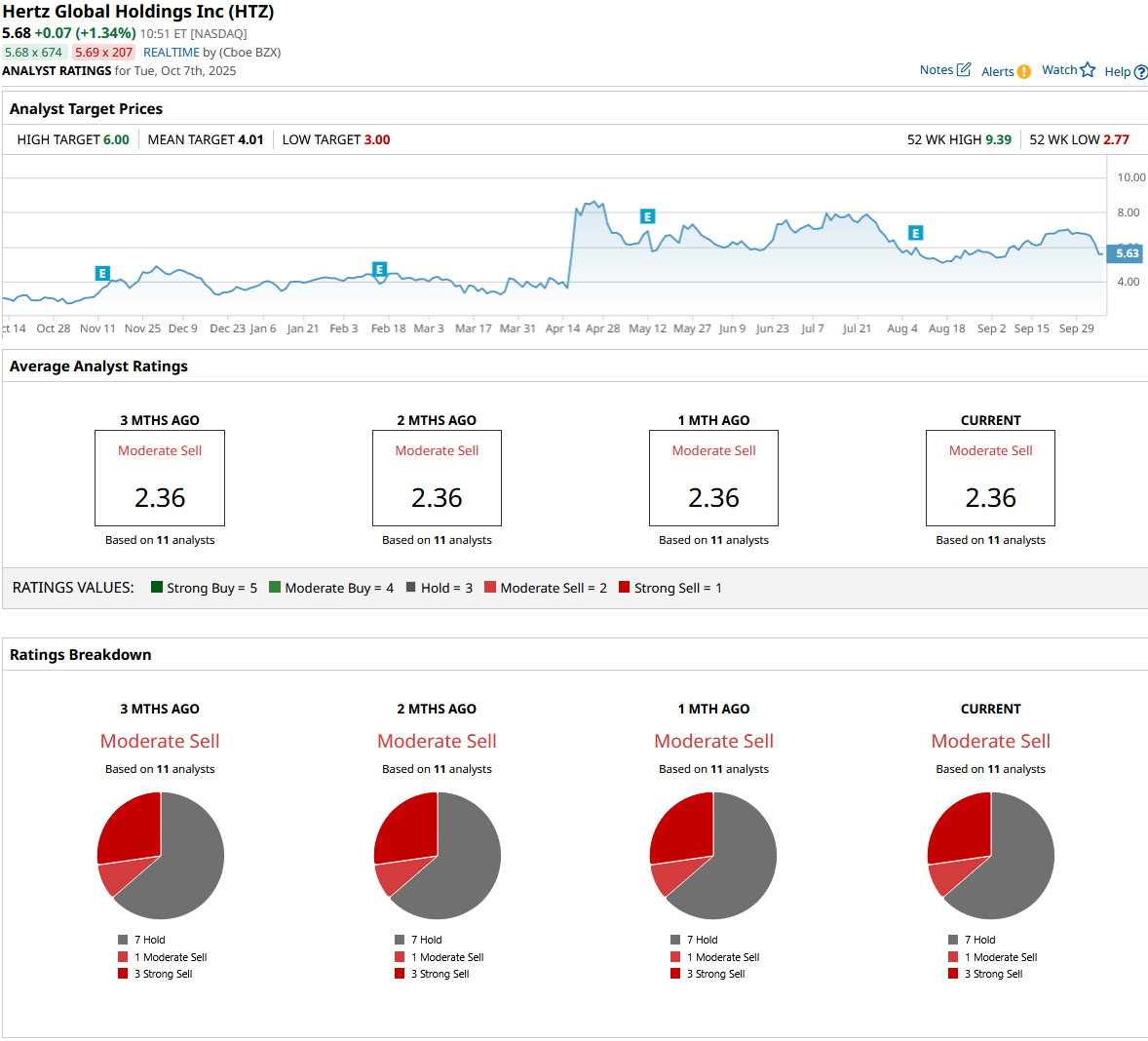Hertz Is Doubling Down on E-Commerce. Does That Make HTZ Stock a Buy Now?

Hertz’s (HTZ) decision to let buyers complete the entire car purchasing process online comes at a moment when the auto market is shifting fast toward simple, digital buying habits. Over the past year, the company has added key partnerships, including a collaboration with Amazon (AMZN) Autos that pushed its e-commerce push into the headlines and put its inventory in front of a much larger audience.
Industry forecasts suggest 15 percent of car purchases in the U.S. could be fully online by 2026, which makes this move less optional and more necessary as shoppers increasingly expect an end-to-end online experience. For Hertz, which manages a fleet of roughly 560,000 vehicles, the goal is clear: improve resale outcomes by making it easier to find, finance, and finalize a purchase without friction.
HTZ shares climbed on these developments, reflecting growing attention on the strategy, but the key question remains the same: is this online pivot enough to justify the stock at current levels? Let’s take a closer look.
How Hertz’s Financials Stack Up
Hertz runs a business that rents out cars and also sells its vehicles directly to shoppers through its growing used-car sales division. Over the past year, the stock has gained nearly 64% and is up more than 50% since January.

Even as shares have climbed, the company’s numbers still look tough. Market value stands around $1.7 billion, but recent results include a loss of $0.34 per share for the last quarter and a trailing yearly loss of $3.32 per share.
The story shifted for Hertz in the second quarter. This was the first time in almost two years that its core profits turned positive, with net income and adjusted EBITDA improving by about $500 million compared to last year.
The strategy of buying, holding, and selling cars smarter seems to be working. Depreciation per vehicle is down to $251 a month, much lower than the company’s $300 target, and Hertz is using its cars much more efficiently, raising vehicle utilization to 83%. Moreover, retail car sales reached a five-year high for the second quarter, giving a clear signal that digital sales efforts are connecting with buyers. With over $1.45 billion in liquidity and a 3% drop in direct operating costs, Hertz has started to build a stronger financial footing.
Key Growth Catalysts Behind Hertz’s Online Transformation
Hertz’s digital leap starts with turning its online catalog into a full e-commerce platform. Now shoppers can browse, finance, and purchase a car entirely through HertzCarSales.com with no dealership visits or phone calls. The updated flow also supports trade-ins, pre-qualification to see personal payment options, viewing protection plans, and completing final credit approval online. This makes the process clearer and easier while opening up access to more buyers in a way that matches how cars are increasingly being bought.
This reach expands further with Hertz’s new presence on Amazon Autos. As Amazon’s first fleet dealer, Hertz puts thousands of used cars in front of a wider audience where buyers can shop on Amazon, finish the purchase, and pick up the car at a Hertz Car Sales location.
The rollout starts in Dallas, Houston, Los Angeles, and Seattle, with plans to scale across all 45 Car Sales locations nationwide. Pairing Hertz’s inventory with Amazon’s checkout journey gives the company strong visibility with shoppers who want a simple, online experience.
Hertz is also widening the funnel with Rent2Buy, now in more than 100 cities. The program lets a shopper rent a car for up to three days for a small daily fee to get a true feel for it. If the car is purchased, that rental fee is waived.
This solves a common concern for used-car buyers who want more time before committing. It also converts at a strong rate, with about 80% of renters going on to buy. By reducing hesitation and giving real road time, Rent2Buy builds confidence and lifts retail sales, directly supporting Hertz’s growing online and in-store selling efforts.
What Analysts See Ahead for HTZ
Analysts show some short-term hope for Hertz as they expect earnings to turn positive this quarter with $0.06 per share. However, forecasts become more cautious afterward, with predictions of a $0.46 loss next quarter and deeper annual losses of $1.92 and $0.50 for 2025 and 2026, respectively.
Despite these improvements, skepticism remains strong. J.P. Morgan’s Ryan Brinkman kept his “Underweight” rating in May, pointing out that much of Hertz’s recent financial gains come from temporary advantages such as lower fleet depreciation and high used car prices, which may not last. He also flagged risks like ongoing negative free cash flow, refinancing challenges, and lingering legal costs from the company’s past bankruptcy.
This caution is shared across the board, as the 11 surveyed analysts currently rate HTZ as a consensus “Moderate Sell.” All say to either sell or hold, with no buys. Their average price target sits at $4.01, which is over 35% below the current stock price, suggesting the market’s optimism on the online pivot has not yet shifted the Street’s stance.
Conclusion
At the end of the day, Hertz’s all-in digital pivot is gutsy, timely, and likely to keep it relevant in a rapidly changing market, yet the numbers and expert sentiment urge real caution. With shares trading well above Wall Street’s average target and fundamental risks like negative cash flow and legal overhangs still unresolved, HTZ stock has arguably outrun its underlying recovery for now. Unless Hertz can prove its new online engine delivers actual, lasting profit, odds are the stock will be more volatile than rewarding in the near term. The path upward needs real execution, not just headlines.

On the date of publication, Ebube Jones did not have (either directly or indirectly) positions in any of the securities mentioned in this article. All information and data in this article is solely for informational purposes. For more information please view the Barchart Disclosure Policy here.